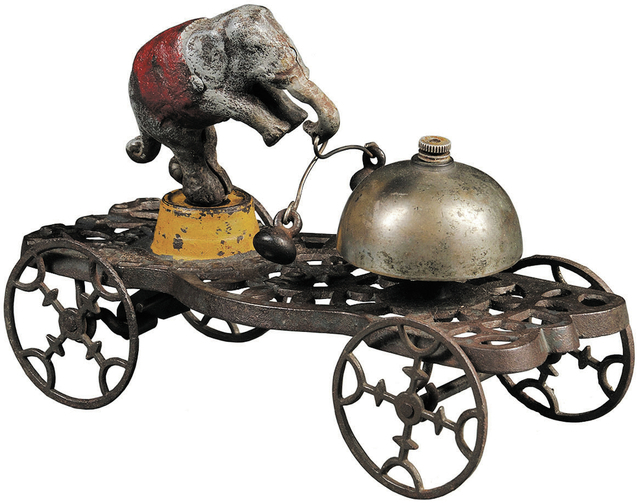Early toy makers did not encourage creativity
Old toys are different from those made today. Toy makers of long ago did not try to encourage creativity. A toy was made to resemble a known part of life — a house, car or pet — or perhaps a fantasy — a rocket ship or robot. Or they were puzzles meant to teach the alphabet or arithmetic, or character dolls from stories that told of good behavior or gave lessons from the Bible.
In the late 19th century, a group of cast-iron bell-ringer toys became popular. These were pull toys with a platform and four wheels. The figures on the platform moved when the toy’s wheels turned. The “Trick Elephant Bell Ringer,” with its name in raised letters on the side, was made by the Gong Bell Manufacturing Co. of East Hampton, Conn. When the toy was pulled, the wheels moved and the elephant turned and hit the bell. The elephant stands on a pierced and painted platform, suggesting that he is a circus performer.
The painted iron toy, about 5 inches high and 8 inches long, sold for $1,230 at a Skinner auction in Boston.
Q: My wife bought what our family refers to as “our dog chair” at a garage sale for $9. It was in a great deal of disrepair and we had it professionally redone. It’s made of walnut, upholstered in leather, and has carved dog’s heads at the end of each arm. The dogs’ faces and collars are slightly different from one another. We were told that one is a female and the other male. I’m not sure if that makes sense. What can you tell me about this chair?
A: Chairs with arms that end in animal heads were popular in Victorian times and later. Dog heads are the ones most often found. Your chair is unusual because the heads are slightly different, but whether they represent a male and female dog is something only the maker would know.
It’s not possible to give an accurate value for your chair since the maker and age are unknown, but you can be sure that your wife got a good value for $9 and an interesting conversation piece after it was refurbished. Value: about $200.
Q: We have a Marx metal dollhouse, purchased in 1956 that’s still in its original, unopened carton. Please tell us what it’s worth today.
A: Louis Marx and Co. was founded in New York City in 1919 and closed in 1978. In the early 1950s, it was the largest toy company in the world. Marx introduced its first metal dollhouses in 1949 and continued to sell a variety of dollhouses into the 1970s. Most sets included plastic furniture and dollhouse-size plastic dolls.
The value of your unopened dollhouse set depends on the house’s design and size. It could sell for $200 to $350. (A furnished house that has been played with would sell for only about $25 to $50.)
Q: I have a perfect set of dishes, marked “Monarch China, Made in Occupied Japan, Montana Rose.” The pieces are decorated with roses and trimmed in gold. There are 96 pieces in the set, which includes 12 place settings and various serving pieces. Can you tell me something about the dishes and how much they’re worth?
A: Your dishes were made between 1947 and 1952, when Allied forces occupied Japan after World War II. They were made specifically for export. Sets of Monarch China’s “Montana Rose” pattern dishes have sold recently for $120 to $250.
Q: My aunt gave me a silver tea set that includes a coffeepot, teapot, sugar, creamer and tray. The coffeepot has a mark on the bottom that says “1883” with a crown in the middle of the number. It also says “F.B. Rogers Silver Co.” I know it’s old, but I’d like to know if it’s considered an antique, if it’s real silver and if it has any value.
A: F.B. Rogers Silver Co. was founded in Shelburne Falls, Mass., in 1883. It moved to Taunton, Mass., in 1886 and became a division of National Silver in 1955. The mark on your coffeepot was used for several years after 1886.
F.B. Rogers made silver-plated tea sets in different styles and sizes. The largest sets include a waste bowl with a lid and a coffee urn. The company also made silver-plated flatware and sterling-silver flatware.
The value for your tea set depends on its condition, style and the total number of pieces in the set. A five-piece set that included a waste bowl sold for $175 earlier this year.
Q: My grandfather gave me a beautiful little cup about 50 years ago, when I was a little girl. I don’t remember ever hearing any history about it. It’s made of some type of metal and stands about 8 inches high. It’s embossed with birds and cattails, and is on a pedestal base that’s engraved “Third Swiss Festival N.Y., July 18th, 1875.” It is marked “Meriden Company.” Can you tell me anything about this curiosity?
A: The Third Swiss Festival was held at Jones’ Woods, a picnic grounds and resort in Manhattan, in 1875. The event included competitions in bowling, equestrian movements, gymnastics, marksmanship, wrestling, singing and dramatic presentations. A silver cup was awarded as first and second prizes in the singing competition.
Meriden was a silver-plate manufacturer in Meriden, Conn. The silver plating may have worn off your cup, leaving the base metal exposed, or it may be a metal replica sold as a souvenir of the event.
Tip: Watercolors and sketches should be kept out of sunlight. Hang framed works on a wall that is shaded.
CURRENT PRICES
Current prices are recorded from antiques shows, flea markets, sales and auctions throughout the United States. Prices vary in different locations because of local economic conditions.
Sioux pottery vase, bulbous, pinched neck, purple, yellow, blue, geometric designs, 6 inches, $20.
Coca-Cola ice pick, wood handle, red letters, 8 5/8 inches, pair, $25.
Insulator, Hemingray No. 16, dark-olive, amber tones, toll style, $30.
Pressed-glass cake stand, milk glass, Atterbury, $50.
Royal Doulton character mug, Albert Einstein, 1995, 7 inches, $85.
Bellows, Regency, brass, mahogany, England, 24 inches, $235.
Northwood carnival glass plate, Rose Show, amethyst, scalloped rim, c. 1925, 1 7/8 by 9 1/2 inches, $750.
Chest, painted flowers, white ground, two drawers, 29½ by 24 inches, pair, $1,065.
Lalique caviar bowl, frosted, 3 dolphin-shape feet, domed cover, 10 by 8 inches, $1,230.
Tiffany bookends, cat, arched back, bronze, stamped, c. 1915, 6 inches, $1,770.
Terry Kovel’s column is syndicated by King Features. Write to: Kovels, (Las Vegas Review-Journal), King Features Syndicate, 300 W. 57th St., New York, NY 10019.




























